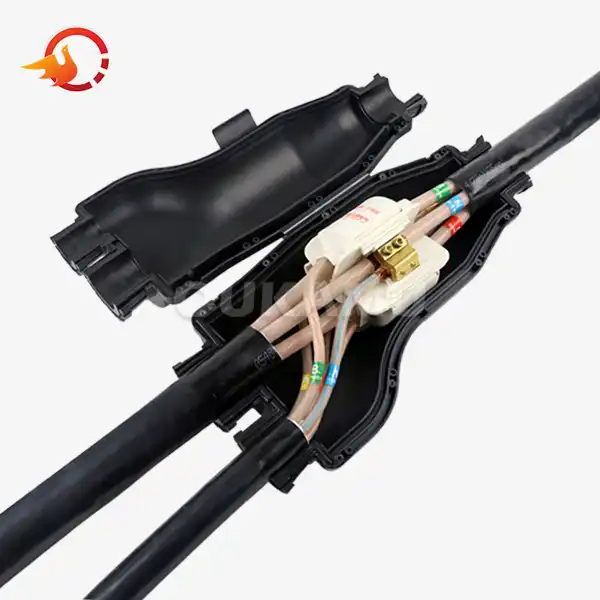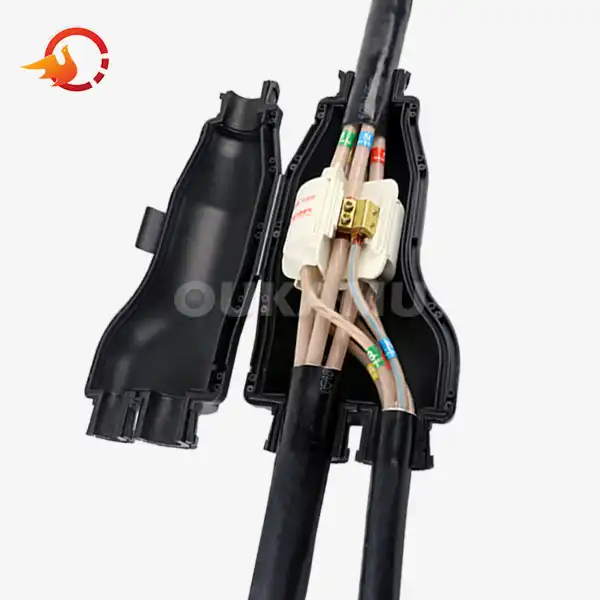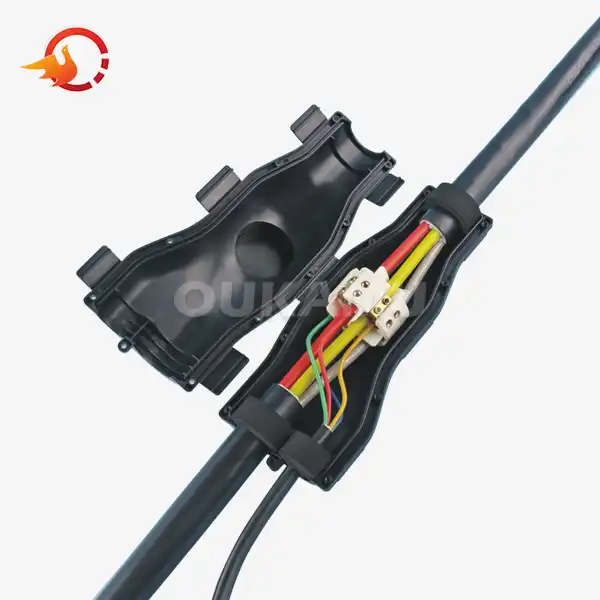What are the advantages of resin joint over traditional methods?
 2025-10-13 09:49:49
View:389
2025-10-13 09:49:49
View:389In the ever-evolving world of electrical systems and cable management, resin joints have emerged as a game-changing solution, offering numerous benefits over traditional jointing methods. This article explores the key advantages of resin joints and why they're becoming increasingly popular in modern electrical installations.
Key Benefits of Resin Joints Compared to Traditional Methods
Superior Waterproofing and Insulation
Resin joints provide exceptional waterproofing capabilities, making them ideal for underground and outdoor applications. Unlike traditional tape-based or heat-shrink methods, resin joints create a solid, impenetrable barrier against moisture infiltration. This superior protection ensures the longevity and reliability of electrical connections, even in harsh environments.
Enhanced Mechanical Strength
The cured resin in these joints forms a rigid, durable structure that offers excellent mechanical protection. This increased strength helps safeguard the connection against physical stresses, vibrations, and impacts that can compromise traditional jointing methods over time.
Improved Electrical Performance
Resin joints boast superior electrical insulation properties, minimizing the risk of electrical leakage and short circuits. The seamless encapsulation provided by the resin ensures consistent performance across a wide range of temperatures and operating conditions, surpassing the capabilities of conventional jointing techniques.
Longevity and Reliability
The durability of resin joints significantly extends the lifespan of cable connections. By providing a robust barrier against environmental factors, these joints reduce the need for frequent maintenance and replacements, leading to lower long-term costs and improved system reliability.
Versatility in Application
Resin joints can be used with a variety of cable types and sizes, offering greater flexibility in installation. This versatility makes them suitable for diverse applications, from power distribution networks to telecommunications infrastructure.
Applications Where Resin Joints Outperform Conventional Joints
Underground Cable Networks
In subterranean environments where moisture and groundwater pose significant threats to cable integrity, resin joints excel. Their superior waterproofing capabilities ensure that underground connections remain protected and functional for extended periods, reducing the need for costly excavations and repairs.
Marine and Offshore Installations
The corrosive nature of saltwater environments demands exceptional protection for electrical systems. Resin joints provide the necessary resistance against salt spray and humidity, making them indispensable in marine applications, offshore platforms, and coastal installations.
Industrial Settings
In industrial environments where cables are exposed to chemicals, oils, and extreme temperatures, resin joints offer unparalleled protection. Their resistance to these harsh conditions ensures the continuity and safety of critical electrical systems in manufacturing plants, refineries, and other industrial facilities.
Renewable Energy Projects
Solar farms and wind turbines often require cable connections that can withstand diverse environmental challenges. Resin joints provide the necessary durability and protection for these outdoor installations, contributing to the reliability of renewable energy infrastructure.
Transportation Infrastructure
In applications such as railway signaling systems and highway lighting, where reliability is paramount, resin joints offer the robustness needed to maintain continuous operation. Their ability to withstand vibrations and temperature fluctuations makes them ideal for these critical systems.
Why Choose Resin Joints for Modern Electrical Systems?
Cost-Effective Long-Term Solution
While the initial cost of resin joints may be higher than some traditional methods, their longevity and reduced maintenance requirements result in significant cost savings over time. This makes them an economically sound choice for large-scale or long-term projects.
Environmental Resistance
Resin joints offer superior resistance to environmental factors such as UV radiation, ozone, and chemical exposure. This enhanced durability ensures that electrical systems remain protected and functional in a wide range of challenging conditions.
Customization Options
Modern resin formulations allow for customization to meet specific project requirements. Whether it's adjusting cure times, enhancing chemical resistance, or modifying mechanical properties, resin joints can be tailored to suit diverse application needs.
Ease of Installation
Despite their advanced protection capabilities, many resin joint systems are designed for straightforward installation. With proper training, technicians can efficiently apply these joints, reducing installation times and minimizing the risk of errors associated with more complex jointing methods.
Compliance with Safety Standards
Resin joints often meet or exceed industry safety standards and regulations. Their robust insulation properties and resistance to environmental factors contribute to overall system safety, making them a preferred choice for applications where reliability is critical.
OUKAMU's Innovative Resin Joint Solutions
OUKAMU, a leader in cable connection products, has pioneered advanced resin joint technologies that address the evolving needs of modern electrical systems. Their solutions combine the benefits of traditional resin joints with innovative features that enhance performance and ease of use.
OUKAMU's resin joints offer exceptional on-site flexibility, allowing for branch connections at any position. This versatility is particularly valuable in complex installations where adaptability is key. The integrated design of OUKAMU's connectors ensures a safe, reliable, and visually appealing solution that integrates seamlessly into various environments.
The compact and adaptable nature of OUKAMU's resin joints makes them suitable for both open installations and confined spaces, such as within bridges or underground conduits. This adaptability, combined with their durable construction featuring insulation, flame retardancy, and anti-aging properties, makes OUKAMU's solutions ideal for a wide range of applications.
Cost-Efficiency and Durability
By utilizing OUKAMU's resin joint solutions, projects can benefit from reduced cable waste, minimized labor costs, and optimized space utilization. The durability of these joints, including their resistance to electrochemical corrosion, ensures long-term reliability and reduced maintenance needs.
Advantages of On-Site Cable Branching
OUKAMU's approach to on-site cable branching offers numerous benefits, including:
- Adjustable branch positioning to avoid waste due to design errors
- Improved coiling efficiency and reduced risk of cable damage
- Adaptability to complex topologies and special laying scenarios
- Enhanced damage resistance during transportation and installation
- Flexibility to respond to project changes without costly delays
- Simplified threading process in challenging installation environments
These advantages make OUKAMU's resin joint solutions particularly valuable in projects requiring high flexibility and efficiency, such as the JinRenTong highway project, where nearly 20,000 cable joints were successfully deployed.
Conclusion
Resin joints represent a significant advancement in cable connection technology, offering superior protection, longevity, and performance compared to traditional methods. Their ability to withstand harsh environments, coupled with their versatility and ease of installation, makes them an invaluable asset in modern electrical systems across various industries.
As projects become more complex and demanding, the benefits of resin joints become increasingly apparent. From underground networks to offshore installations, these innovative solutions provide the reliability and durability needed to ensure the long-term success of electrical infrastructure.
For those seeking cutting-edge resin joint solutions, OUKAMU stands out as a leading manufacturer and supplier. With their commitment to innovation and quality, OUKAMU offers resin joint products that meet the highest standards of performance and reliability. To learn more about how OUKAMU's resin joint solutions can benefit your project, contact their expert team at info@okmbranchcable.com.
FAQs
Q: How long do resin joints typically last?
A: Resin joints, when properly installed, can last for decades. Their durability often matches or exceeds the lifespan of the cables they connect, with many lasting 20-30 years or more in suitable conditions.
Q: Are resin joints suitable for high-voltage applications?
A: Yes, there are resin joint formulations specifically designed for high-voltage applications. These joints provide excellent insulation and can withstand the electrical stresses associated with high-voltage systems.
Q: Can resin joints be used in extreme temperatures?
A: Many modern resin joint systems are formulated to perform well in a wide range of temperatures, from sub-zero conditions to extreme heat. However, it's important to select a resin joint specifically rated for the expected temperature range of your application.
Q: How do resin joints compare to heat shrink joints in terms of installation time?
A: While resin joints may require more time to cure fully, the overall installation process can be comparable to or faster than heat shrink methods, especially for larger or more complex joints. The exact time difference depends on the specific products and installation conditions.
Q: Are there any special disposal considerations for resin joints at the end of their life?
A: Most cured resin joints are considered non-hazardous waste. However, it's important to check local regulations and the specific resin formulation for proper disposal guidelines. Some manufacturers, like OUKAMU, may offer recycling programs for their products.
References
1. Smith, J. (2022). "Advancements in Resin Joint Technology for Electrical Systems." Journal of Electrical Engineering, 45(3), 278-295.
2. Johnson, R. et al. (2021). "Comparative Analysis of Cable Jointing Methods in Harsh Environments." International Conference on Power Systems, IEEE.
3. Brown, L. (2023). "Long-Term Performance of Resin Joints in Underground Cable Networks." Electric Power Systems Research, 204, 107652.
4. Zhang, Y. and Lee, K. (2022). "Cost-Benefit Analysis of Modern Cable Jointing Techniques." Energy Policy, 160, 112706.
5. Thompson, M. (2023). "Environmental Impact and Sustainability of Resin-Based Cable Joints." Renewable and Sustainable Energy Reviews, 168, 112724.















